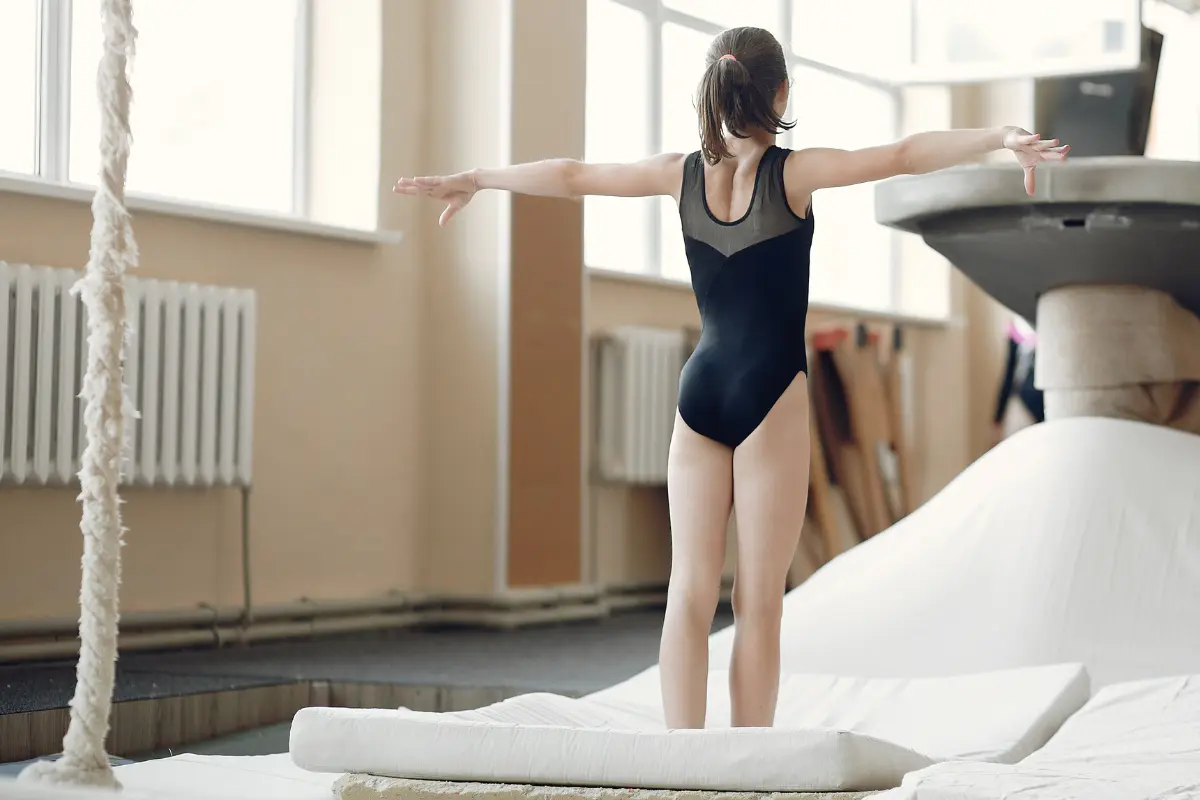In gymnastics, every movement counts, and even the smallest imperfection can affect a gymnast’s score. When it comes to landings, the two most common errors that athletes make are the hop and the step. While both can lead to deductions, they affect the score in different ways.
What is a Hop?
A hop happens when both feet leave the ground at the same time, and the gymnast lands back on both feet, but with a small bounce or jump.
It’s usually a sign that the gymnast wasn’t able to absorb the impact of the landing properly and had to “hop” to regain balance. You might see hops after a vault, dismount, or tumbling pass when the gymnast isn’t completely stable.
Hops can result in a deduction because they show that the gymnast wasn’t in full control. Common reasons for deductions from hops include:
- Lack of Control: If the gymnast hops to regain balance, it usually means they didn’t land solidly.
- Excessive Height: Sometimes, the hop is too big, which can be seen as an unnecessary bounce.
- Form Issues: If the gymnast lands with their knees bent too much or their feet apart, it could result in an additional deduction.
What is a Step?
A step happens when the gymnast lands on one foot first, then steps with the other foot to stabilize themselves. It’s a small adjustment to regain balance.
A step is usually seen when a gymnast lands a dismount or a tumbling pass but needs a little extra time to stabilize. While it’s not as dramatic as a hop, it can still lead to a deduction if not done perfectly.
Steps can lead to deductions for a few reasons:
- Balance Issues: A step typically happens when the gymnast is not quite stable after landing.
- Multiple Steps: If the gymnast takes several steps, it’s more of an issue since it shows they couldn’t regain control with just one step.
- Big or Awkward Steps: A very large or off-balance step can be seen as a bigger mistake than a smaller, more controlled step.
Deductions for Hops and Steps in Gymnastics Landings
According to the FIG Code of Points, which governs the scoring of gymnastics, deductions are given for poor control on landings. While both a hop and a step reflect a lack of control, they are evaluated differently based on their impact on the gymnast’s ability to stick the landing.
Hop Deductions
A hop in gymnastics is generally seen as a minor error. It typically results in a 0.1 deduction from the overall execution score. This deduction applies because the hop indicates a slight lack of balance or control but is not considered a major issue in terms of the gymnast’s ability to land securely.
Example of Hop Deduction:
- A gymnast completes a tumbling pass and lands with both feet but experiences a small hop forward. This would typically result in a 0.1 deduction for lack of control on the landing.
Step Deductions
A step is considered a more severe error in a gymnastics landing than a hop because it suggests a more substantial loss of control. A step generally results in a 0.2 deduction from the execution score. This deduction applies because the gymnast is actively shifting their weight and taking a step to correct their position, indicating a significant issue with balance.
Example of Step Deduction:
- A gymnast lands after a vault and takes two or three steps backward to regain balance. This would result in a 0.2 deduction for the step, as well as potential additional penalties depending on the severity.
How Multiple Steps Affect Deductions
When a gymnast takes multiple steps to regain balance, the deductions can accumulate. The standard deduction for a single step is 0.2, but if the gymnast continues stepping or takes an excessive number of steps, the judges may apply additional deductions. For instance:
- Two steps: This could result in a 0.2 deduction.
- Three or more steps: This may increase the deduction to 0.3 or 0.4, depending on the extent of the instability.
In extreme cases, where the gymnast takes several steps or stumbles significantly, it can result in a 0.5 deduction or more, depending on how much the gymnast deviates from a stable, controlled landing.
Which Leads to Greater Deductions: Hop or Step?
While both hops and steps can lead to deductions, steps tend to result in greater penalties than hops due to their more significant indication of instability.
A hop is generally seen as a smaller error, and the gymnast is typically able to regain balance with minimal movement. On the other hand, a step is more deliberate and often signals a more considerable loss of control, leading to a larger deduction.
- Hop: Typically results in a 0.1 deduction, as it indicates minor instability and a small shift in balance. If the hop is exaggerated, the deduction could rise to 0.2.
- Step: Usually results in a 0.2 deduction. If the gymnast takes multiple steps, the deduction can increase to 0.3 or higher. The more steps taken, the more substantial the loss of control appears to be, leading to larger penalties.
Final Words
Both hops and steps can hurt your gymnastics score, but steps usually lead to bigger deductions, especially when there are multiple steps or they’re too big. While a hop is a sign of losing control of the landing, it usually only results in one penalty. A step, on the other hand, can mean a gymnast is struggling to regain balance, and multiple steps add up to more deductions.
To avoid penalties, gymnasts should aim to land as cleanly and smoothly as possible. Whether you’re landing after a vault, a tumbling pass, or a beam dismount, keeping your balance and sticking the landing (without hopping or stepping) will help you avoid costly deductions and score higher.





